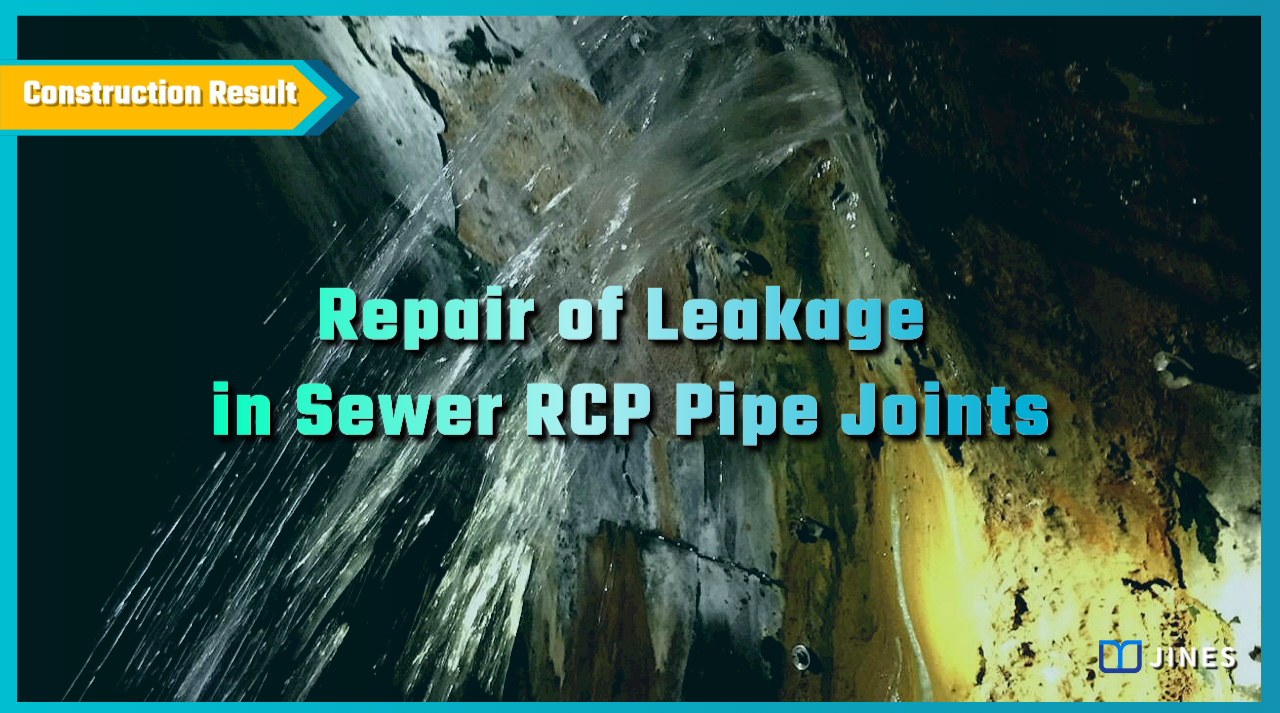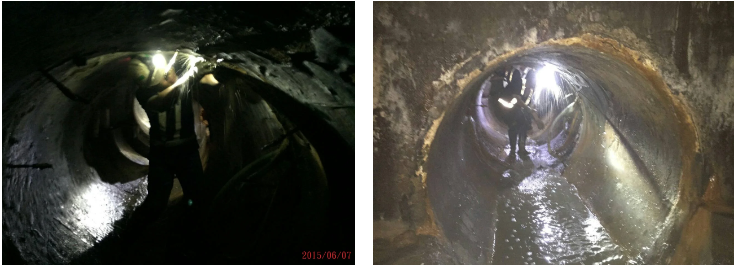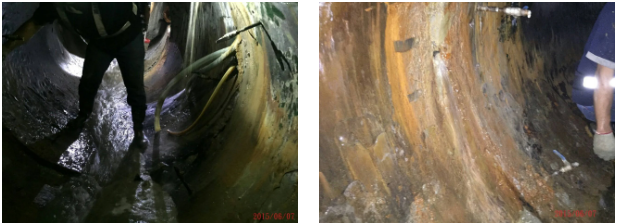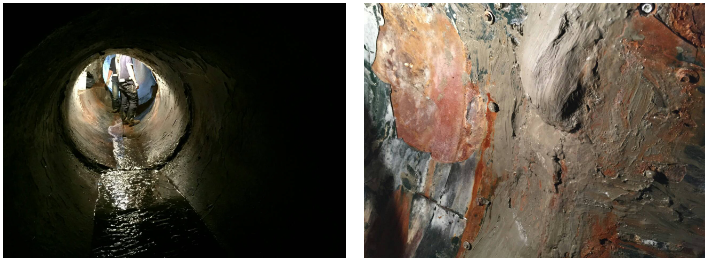
REPAIR OF LEAKAGE IN SEWER RCP PIPE JOINTS
Pipe leak sealing and surrounding ground improvement and reinforcement techniques
1. Project Background
A sewage RCP pipe in a sewer system was suspected to have developed cracks in the joints due to nearby construction activities, resulting in inrush groundwater containing fine sand into the pipe.
To prevent continued water and sand inrush causing severe undermining of the surrounding soil layers, the responsible authority dispatched personnel to inspect the site. Initially, rubber pads were installed at the leakage points to reduce the inrush of water.
Subsequently, a professional contractor was commissioned to develop an improvement plan, which was approved during the review process.
Repair work was carried out based on the approved plan.

―
2. Solution
The occurrence of water inrush in the RCP pipe was observed at a depth of approximately GL-6.0m, with a diameter of 1.2m.
During the site inspection, two significant water inrush points were identified at the locations of the cracks, and sediment deposition due to groundwater inflow was found inside the pipe.
The surrounding soil was assessed to have experienced significant undermining.
To address the water inrush at the pipe joints and reinforce the surrounding soil, the following solution was proposed:
- Temporarily seal the water inrush points to reduce the flow velocity and volume.
- Use resin grouting to seal the cracks at the pipe joints and prevent water inrush.
- Inject cementitious grout material externally into the pipe, filling voids and applying moderate pressure to the loose soil zone.
- Employ pre-embedded grouting method to avoid prolonged work within the confined pipe space.
- Develop ventilation, safety measures, and emergency contingency plans for the pipeline to ensure operational safety.

―
3. Works Design
The repair work for water inrush in the pipeline adopted a combined approach of crack sealing and surrounding soil consolidation.
The works design was as follows:
a. Temporarily seal the two significant water inrush points and crack seepage areas using filling materials mixed with rapid-setting cement. This reduces the flow velocity of groundwater, preventing material washout or disintegration during subsequent grouting.
b. Install resin grouting pipes and packers at approximately 15 cm intervals on both sides of the cracks, with a spacing of approximately 30 cm between each grouting pipe. The drilling to be performed at a 45-degree angle.
c. Divide the circumference of the RCP pipe joints into 12 equal parts. Pre-embed one grouting pipe with an accompanying valve for ground improvement at each location. The grouting pipe to be primarily embedded to penetrate the RCP pipe and reach the soil layer, with adjustments made as necessary based on soil undermining conditions.
d. Perform secondary injection of polyurethane resin, both expanding and non-expanding types. Start the injection from the lowest grouting hole and utilize adjacent upper grouting pipes as overflow holes. Complete the resin grouting process sequentially.
e. Use water-cement ratio (W/C) of 0.6 to 1.0 for cement grout to consolidate the surrounding soil. Start the grouting from the lowest grouting hole and utilize adjacent upper grouting pipes as overflow holes. Adjust the W/C ratio, final grouting pressure, and grout volume based on the overflow condition.
f. Once the complete elimination of water inrush is confirmed, remove the exposed grouting pipes, fill the holes, and restore the pipe wall using non-shrinkage cement mortar.


―
4. Works Process
Due to the limited space inside the RCP pipe, the grouting equipment was hoisted in a manhole and at ground level.
It was then connected to the pre-embedded fittings through high-pressure pipes for injection.
During the works process, in addition to maintaining proper ventilation and other safety measures, dedicated safety personnel were assigned to monitor the operations inside the pipeline from the ground surface.
Furthermore, during the site investigation, it was observed that there was a localized 3 cm void at the RCP pipe joint.
To prevent future leakage, special attention had to be paid to ensuring complete coverage of this area during the external soil improvement of the pipeline.

―
5. Results
After completing all the work according to the construction design, there was no longer any water seepage observed at the original cracks and RCP pipe joints.
Following 14 days of normal operation of the sewer, a site inspection was conducted and reported to the supervising authority.
No further leakage was observed in the repaired area, successfully accomplishing the repair work for the leakage at the RCP pipe joints in the sewer.

・More Construction Result Sharing
Contact us:+886 2769-2355
Copyright ©Jines Construction Co.,Ltd